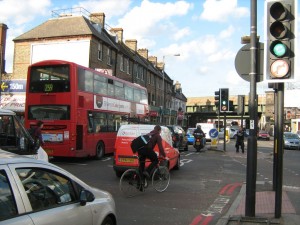
A few weeks ago I went to a talk by Andrew Gilligan, the Mayor of London’s Cycling commissioner. Andrew is charged with turning the Mayor’s ‘Vision for Cycling’ into reality. It was very exciting hearing someone with serious political power talking about Transport for London’s plans to build a comprehensive network of cycle routes, with segregation where needed. He made it clear that as well as the headline grabbing routes, the majority of the network will be based on local borough roads.
His primary mission is to develop linked up routes, allowing non-cyclists to see that riding is a safe and convenient way to travel. As part of that network, the whole one way system between Finsbury Park and Holloway may be re-engineered. How this happens is up for debate.
I would argue for the inclusion of two-way, fully segregated cycle tracks, designed to Dutch standards.

Here’s why:
- By giving cycling it’s own dedicated lanes you enable children to ride to school and the elderly to use bikes to get around
- It encourages better behaviour by cyclists using the streets. Again by having a space which is safer to use, they are less likely to ride on pavements. Traffic signals can be phased to cycling speeds, with less temptation to jump red lights.
- It’s good for motorised traffic. Drivers have fewer cyclists filtering around vehicles.
- If we want lots more people cycling, we need direct and visible routes to where people want to go. It’s no good just offering quiet back routes. They can sometimes be less direct and harder to navigate. In addition, destinations are usually on the high-street. Shops, cinemas and libraries are all places where people go locally. These are all on main roads.

What is clear is that if London wants to become more liveable, cycling has got to be regarded as a natural, simple and economic method of transport. We need to develop joined up continuous networks. As cycling advocates, we should be requesting and sometimes demanding facilities for people who don’t feel able to ride. It can be difficult to imagine a mass cycling culture, but for people who have seen it, the contrast between those streets and London roads is stark. Yes, lots of changes need to be made, but TfL and the DfT are making changes to UK laws to allow re-engineering of roads to work more like European systems.
Compare Seven Sisters Road with a Dutch city street

Returning Seven Sisters Road to 2 way operation rather than taking the opportunity to incorporate proper ‘Dutch’ design infrastructure would in my view be a mistake. If you want to see what Seven Sisters Road would look like if it were two way, then just head to Finsbury Park. This is no pedestrian paradise. Or take a trip up to Green Lanes, shopping city.
Economics
Making routes people and cycle friendly is of course much better for both the physical environment but also the economics of the area. Many studies have shown that with increased footfall and cycling usage, shops benefit from an increase in revenues.
Health
Islington’s Air Quality is very poor. The borough suffers from worse air pollution than the London average with over 50% higher levels of dangerous airborne particles than the World Health Organisation limits.
In conclusion, the moment to push cycling forward properly is now. The Mayor has said ‘Cycling will be treated not as niche, marginal, or an afterthought, but as what it is: an integral part of the transport network, with the capital spending, road space and traffic planners’ attention befitting that Role’.
Islington along with Hackney and Haringey Councils have said as part of a tri-borough ‘Accord’ they want to encourage walking and cycling for local residents and visitors. This should include joint working with TfL to improve pedestrian and cycling links across Seven Sisters Road.
London Cycling Campaign has been extremely clear on creating ‘Dutch’ style conditions, and it became their principle campaign last year.They got complete support from all the Mayoral candidates, who all agreed to back the campaign demands. 40,000 people signed the campaign, showing that there is a huge demand for safer cycling conditions. The Cycling Touring Club has very similar views.
We should not be so hasty as to want to remove the one way system if this diminishes the ability to implement proper cycle routes and improve the quality of the local environment. We must not squander this opportunity to create real change.
Jono Kenyon




Thanks Jono, I fully agree. We certainly shouldn’t be pursuing two-way motor traffic at the expense of great cycling facilities. As you suggest, Green Lanes is awful to cycle on, and pretty unfriendly for pedestrians too.
Thanks Jim. Indeed. Everyone (LCC, CTC, British Cyclists and even TfL) are recognising the need to do more than ‘encourage’ cycling. We as advocates should be clear of our desire, and I am determined to present the case for Going Dutch, so that everyone can see it is the obvious choice!
I think most people would only consider cycling on Seven Sisters if it had segregated bike lanes, therefore this is the only solution which can match the aspiration of restoring cycling to a mode of transport for everyone of all ages.
Thanks for the comment Fred. I agree completely. If TfL are actually considering a full re-engineering of the whole Seven Sisters Road/Nags Head scheme, then I think we should be asking for world class cycling facilities. I don’t think that making life better for cycling makes it worse for other transport groups unless done badly. As I say in the piece, I want the option of cycling opened up to many more people. It is clear this requires segregation on main roads.
I agree with segregation: it is crucial that children learn from the start that they can move around safely and can do so throughout life.